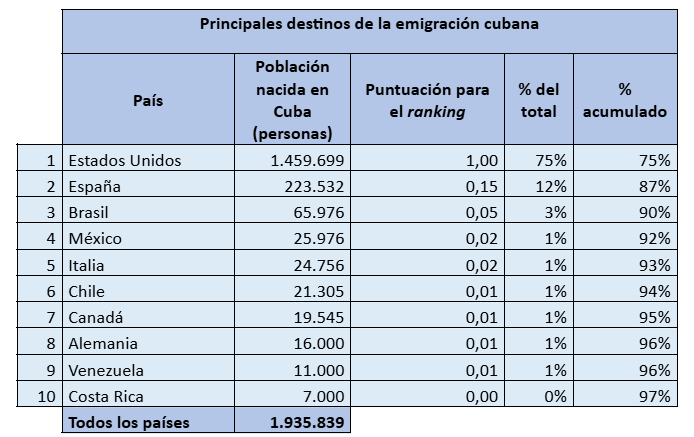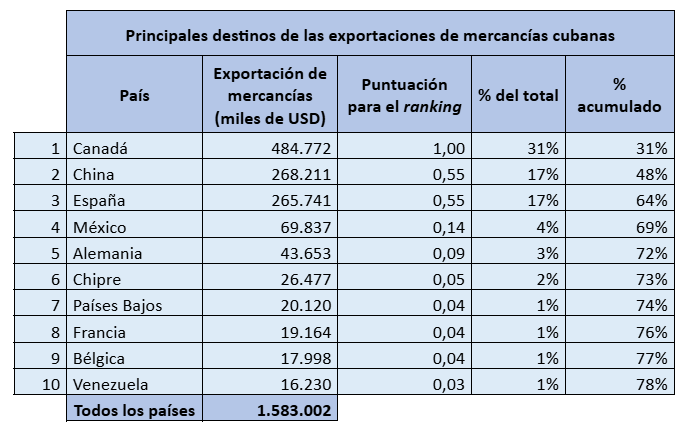Measuring the relative importance of Cuba’s bilateral economic relations, if we intend to do so with scientific precision, is an impossible mission. Essential data are lacking or rather, such information certainly exists, but it is treated as a state secret, mainly due to the policy of economic strangulation pursued by successive U.S. governments for more than sixty years.
This is the case, for example, with foreign investment in Cuba, for which no figures are publicly reported on its annual flows and cumulative amounts.
On the other hand, regarding the value of exported services, Cuba’s main source of foreign currency earnings for many years, the National Office of Statistics and Information (ONEI) only offers global data, without a breakdown by country.
Thus, while thanks to the Cuban Statistical Yearbook we know that in 2023 Cuba exported services (with medical services as the main item) worth USD 6.827 billion (more than quadrupling the USD 1.583 billion obtained through merchandise exports), it is not possible to specify which countries are the main recipients of these services or their respective economic values.
Nor is there accurate, reliable, and distributed information by country regarding the sending of remittances to Cuba, one of its main sources of foreign currency income and a vital resource for the survival and sustenance of many individuals and families. We will return to these issues later in the corresponding section.
Faced with so many significant information gaps, those of us interested in assessing the relative importance of Cuba’s bilateral economic relations have no choice but to move within the realm of the possible and, relying on sometimes incomplete and always imperfect data, at least attempt to approximate this knowledge.
To this end, I have designed an auxiliary (and as simple as possible) statistical method to compile a ranking of Cuba’s bilateral economic relations, according to their respective relative or comparative weights. This method can be updated periodically based on the availability of new data on the underlying variables.
From the outset, I emphasize the auxiliary nature of this quantitative tool, given that it can in no way replace subsequent, more in-depth, and eminently qualitative analyses, which will ultimately allow for a comprehensive and definitive assessment of the matter.
Description of the method
The method presented here is based on the statistical analysis of the behavior of four highly relevant variables to measure the importance of Cuba’s economic relationship with each country, namely:
- Cuban emigrants residing in the country
- Exports of Cuban goods to that country
- Imports of goods from that country to Cuba
- Visitors to Cuba from that country
The ranking obtained will be the result of the arithmetic average of the grading achieved by each country on the four variables considered. These gradings will range from 0 to 1.
For each variable, the country with the highest value will receive a grading of 1, while the grading for all other countries will be determined by the rule of three or, in other words, by dividing the country’s value by the highest value. This will determine the relative weight of each country in that variable.
Below, I will describe the ranking process. In this case, although this is the “snapshot” taken at the end of May 2025, based on the most recent data available, it should be kept in mind that there is always a statistical lag, and therefore, these data refer to previous years, between 2020 and 2024.
I will explain this specifically when analyzing each variable separately, before presenting the resulting multivariate ranking.
Cuban emigration
The economic importance of emigration is obvious.
Remittances are one of the main sources of foreign currency income for Cuba, although, as most of them travel through informal channels, precise figures on their annual value are not available. Estimates for 2023 range from less than USD 1 billion to USD 2.458 billion.
In any case, in a context of extreme worsening of the national economic crisis, these flows (both in cash and in kind) are becoming increasingly crucial for the sustenance of many individuals and entire families.
Also, as an authorized Cuban economist has pointed out, they play a key role as working capital for the private sector.
Given the absence of official data on remittances, the inclusion of Cuban emigration as one of the four variables in the statistical tool presented here allows us to take into account (albeit only indirectly or implicitly) this increasingly necessary injection of resources into the hard-hit Cuban economy.
Furthermore, during 2024, more than 294,000 members of the Cuban community abroad traveled to Cuba, with all the positive economic impacts that these visits entail.
Of the four variables considered, emigration is the most problematic when compiling the corresponding database. This is because there is no single statistical source.
Neither the ONEI nor any other Cuban institution regularly publishes estimates on Cuban emigration broken down by destination country. Therefore, it is necessary to rely on information from the respective national institutions that report on the number of Cuban migrants in each country.
Fortunately, in the two main destinations for Cuban emigration, the United States and Spain, which together account for 87% of our migrants, their respective statistical authorities regularly publish data on the Cuban-born population.
In the United States, this information is provided by the United States Census Bureau, and the most recent estimate corresponds to 2023. In Spain, it is reported by its National Institute of Statistics and is already updated through last year.
However, for all other countries, the most recent data available are estimates for 2020, based on data from the United Nations Population Division.
The following table reflects the top ten destinations for Cuban emigrants, according to the most recent data available, and the corresponding gradings for the ranking, based on the procedure described above.

Merchandise exports
The export of goods is one of the main sources of foreign currency earnings for the Cuban economy and, according to figures reported by the ONEI, reached a value of USD 1.583 billion in 2023.
The following table reflects the top ten destinations for Cuban merchandise exports and the corresponding gradings for the ranking. Canada, China and Spain are, by far, the main markets for Cuban products.

Merchandise imports
Historically, the Cuban economy has relied heavily on imports to function. According to the most recent figures reported by the ONEI, in 2023 imports accounted for 85% of Cuba’s total trade in goods with the rest of the world.
The following table reflects the top ten origins of merchandise imports and the corresponding gradings used to compile the ranking. Venezuela, Spain and China are the main sellers to the Cuban market, and are the only ones with exports exceeding USD 1 billion.

Visitors to Cuba
Despite the crisis facing tourism in Cuba, its authorities persist in maintaining this sector as one of the country’s main economic activities.
The following table shows the distribution of the main source markets for visitors to Cuba in 2024, according to figures reported by the ONEI. Canada is by far the largest source.

The U.S. source market, in addition to the more than 142,000 visitors of that nationality, would be credited with accounting for a vast majority of the nearly 295,000 members of the Cuban community living abroad who visited Cuba last year.
However, the figures reported by the Ministry of the Interior’s Department of Identification, Immigration and Aliens, through the ONEI, do not offer a breakdown that would allow for this statistical analysis.
However, it is important to note that the proposed method already reflects the economic importance of the Cuban community living in the United States in the travel sector, albeit indirectly, by including the emigration variable.
The multivariate ranking (updated as of May 30, 2025)
By calculating the arithmetic mean of the gradings obtained in each of the four variables considered, the following general multivariate ranking of Cuba’s bilateral economic relations is obtained, according to their respective relative weights, always taking into account the information limitations mentioned at the beginning of the text. The 20 relations with the highest gradings are reflected here, in descending order (1).

Main limitation of ranking
As I pointed out at the beginning of this article, the main limitation of the ranking is the lack of official data on some variables that would be particularly relevant to measuring, as accurately as possible, the relative weight of each of Cuba’s bilateral relations.
In the case of foreign direct investment, countries such as Canada, Spain and Vietnam (the latter recognized by the Cuban authorities as the main Asian investor in Cuba) would achieve a higher grading than they already have.
Regarding services exports, Cuba’s main source of foreign exchange earnings (USD 6.827 billion in 2023 and which reached USD 10.24 billion in 2019), it would be especially useful to have this information broken down by country.
In this case, the vast majority of CARICOM member countries; Latin American countries such as Mexico and Venezuela; African countries such as Angola, Namibia and South Africa; Arab countries such as Saudi Arabia, Algeria and Qatar; or a European country like Italy, which receive a significant number of Cuban medical collaborators, would surely also achieve higher gradings.
In this regard, one could consider using the figures for collaborators in each country as an indirect way to approximate the distribution of services export revenues, but such a procedure would pose complexities that are very difficult to resolve, given that the information on the subject is very fragmented and dispersed, and official data are not systematically published.
Some conclusions
The resulting ranking reveals several observations and interpretations that could spark debate and encourage deeper and more comprehensive research, in order to include qualitative elements that should always complement any statistical tool such as the one proposed here, which is inevitably incomplete and subject to improvement.
- Canada, Spain, the United States, China and Venezuela are currently Cuba’s main economic partners, in that order.
- The United States’ placement in third place may surprise some, given the persistence and intensification of the policy of economic strangulation against Cuba. The United States, as a country, is a very important economic partner for Cuba, despite its government, as a result of economic relations that, although very hindered, inevitably develop between both nations’ respective societies. This reality should not lead to the conclusion, always politically motivated and spurious, that the policy of economic blockade against Cuba does not exist or is irrelevant. Such a policy is amply proven and documented, and it causes enormous damage to the Cuban economy. On the contrary, the inference that should always be drawn is that, if the blockade did not exist, the United States would be Cuba’s main economic partner, with a vast advantage over any other country.
- Russia’s seventh position does not seem to correspond to the media coverage given to this bilateral relationship by both the Cuban government and its detractors. There is no doubt that Russia is an important economic partner for Cuba, but only that, just another important partner, until proven otherwise in practice.
- Among Cuba’s twenty main economic partners are six Latin American countries: Venezuela (fifth), Mexico (sixth), Brazil (ninth), Argentina (eleventh), Colombia (sixteenth) and Panama (seventeenth).
- Following a classification proposed in previous works to analyze the geopolitical distribution of Cuba’s foreign trade, of Cuba’s twenty main economic partners, ten (including the top three) are part of the group I have called “United States + European Union (EU) + allies and associates,” two belong to the group “China + Russia and its allies,” and eight are non-aligned countries (not to be confused with the member countries of the Non-Aligned Movement) with either of the two previous groupings.
This diversified configuration of foreign economic relations, in my opinion, constitutes further evidence of the need for the Cuban government to deepen a foreign policy of active non-alignment, based on national interest and, in particular, on long-delayed economic prosperity.
________________________________________
Note:
1. The reader can access the complete list of 192 countries on the author’s Telegram channel.










